Numerical Study of Periodic Magnetic Field Effect on 3D Natural Convection of MWCNT-Water/Nanofluid with Consideration of Aggregation
Abstract
1. Introduction
2. Physical Model
2.1. Governing Equations
- -
- Density:
- -
- Heat capacitance:
- -
- Dynamic viscosity:
- ra is the radii of the aggregates;
- rp is the radii of the primary solid particles;
- D is the fractal index depending on shear flow condition and type, size, and shape of the aggregates.
- is the transverse thermal conductivity;
- is the longitudinal thermal conductivity;
- is the nanoparticle diameter;
- is the nanoparticle length;
- is the Kapitza radius;
- is the Kapitza resistance (fixed at 8.83 × 10−8m2 K/W);
- is volume fraction of the MWCNT in the aggregate.
2.2. Boundary Conditions
3. Solution Procedure, Grid Sensitivity Test, and Validation
4. Results and Discussion
5. Conclusions
- The addition of MWCNT particles enhances the convective heat transfer, increases the vortices’ sizes, and promotes the vertical stratification of the temperature field.
- Lower heat transfer is observed with the increasing Hartmann number and the variation of heat transfer is almost smooth. In other words, oscillation of heat transfer becomes very weak.
- For the same Hartmann number, higher heat transfer and lower amplitude are formed at a higher nanoparticle volume fraction.
Author Contributions
Funding
Conflicts of Interest
Nomenclature
| Magnetic field () | |
| Be | Bejan number |
| Cp | Specific heat at constant pressure (J/kg·K) |
| Dimensionless electric field | |
| Direction of magnetic field | |
| g | Gravitational acceleration (m/s2) |
| Dimensionless density of electrical current | |
| k | Thermal conductivity (W/m.K) |
| l | Enclosure width |
| n | Unit vector normal to the wall |
| Dimensionless local generated entropy | |
| Nu | Local Nusselt number |
| Pr | Prandtl number |
| Ra | Rayleigh number |
| t | Dimensionless time () |
| T | Dimensionless temperature [ |
| Cold temperature (K) | |
| Hot temperature (K) | |
| To | Bulk temperature [To = (c + h)/2] |
| Dimensionless velocity vector () | |
| x, y, z | Dimensionless Cartesian coordinates (, , ) |
| Greek symbols | |
| Thermal diffusivity (m2/s) | |
| Thermal expansion coefficient (1/K) | |
| Density (kg/m3) | |
| Dynamic viscosity (kg/m.s) | |
| Kinematic viscosity (m2/s) | |
| Dimensionless electrical potential | |
| Nanoparticle volume fraction | |
| Electrical conductivity | |
| Dimensionless vector potential () | |
| Dimensionless vorticity () | |
| Dimensionless temperature difference | |
| Subscripts | |
| av | Average |
| c | Cold |
| h | Hot |
| fr | Friction |
| f | Fluid |
| n | Normal |
| nf | Nanofluid |
| s | Solid (nanoparticle) |
| x, y, z | Cartesian coordinates |
| Superscript | |
| ′ | Dimensional variable |
References
- Jaafar, M.; Gomez-Herrero, J.; Gil, A.; Ares, P.; Vazquez, M.; Asenjo, A. Variable-field magnetic force microscopy. Ultramicroscopy 2009, 109, 693–699. [Google Scholar] [CrossRef] [PubMed]
- Izadi, M.; Mohebbi, R.; Delouei, A.A.; Sajjadi, H. Natural convection of a magnetizable hybrid nanofluid inside a porous enclosure subjected to two variable magnetic fields. Int. J. Mech. Sci. 2019, 151, 154–169. [Google Scholar] [CrossRef]
- Hatami, M.; Zhou, J.; Geng, J.; Jing, D. Variable magnetic field (VMF) effect on the heat transfer of a halfannulus cavity filled by Fe3O4-water nanofluid under constant heat flux. J. Magn. Magn. Mater. 2018, 451, 173–182. [Google Scholar] [CrossRef]
- Hashim, A.; Khan, M. Unsteady mixed convective flow of Williamson nanofluid with heat transfer in the presence of variable thermal conductivity and magnetic field. J. Mol. Liq. 2018, 260, 436–446. [Google Scholar] [CrossRef]
- Sheikholeslami, M.; Vajravelu, K. Nanofluid flow and heat transfer in a cavity with variable magnetic field. Appl. Math. Comput. 2017, 298, 272–282. [Google Scholar] [CrossRef]
- Sandeep, N.; Animasaun, I.L. Heat transfer in wall jet flow of magnetic-nanofluids with variable magnetic field. Alex. Eng. J. 2017, 56, 263–269. [Google Scholar] [CrossRef]
- Hatami, M.; Khazayinejad, M.; Jing, D. Forced convection of Al2O3–water nanofluid flow over a porous plate under the variable magnetic field effect. Int. J. Heat Mass Transf. 2016, 102, 622–630. [Google Scholar] [CrossRef]
- Shah, R.A.; Khan, A.; Shuaib, M. On the study of flow between unsteady squeezing rotating discs with cross diffusion effects under the influence of variable magnetic field. Heliyon 2018, 4, e00925. [Google Scholar] [CrossRef]
- Nimmagadda, R.; Haustein, H.D.; Asirvathamb, L.G.; Wongwises, S. Effect of uniform/non-uniform magnetic field and jet impingement on the hydrodynamic and heat transfer performance of nanofluids. J. Magn. Magn. Mater. 2019, 479, 268–281. [Google Scholar] [CrossRef]
- Nassar, M.S.; Hegazi, A.A.; Mousa, M.G. Combined effect of pulsating flow and magnetic field on thermoelectric cooler performance. Case Stud. Therm. Eng. 2019, 13, 100403. [Google Scholar] [CrossRef]
- Kefayati, G.H.R. Lattice Boltzmann simulation of MHD natural convection in a nanofluid-filled cavity with sinusoidal temperature distribution. Powder Technol. 2013, 243, 171–183. [Google Scholar] [CrossRef]
- Al-Salem, K.; Oztop, H.F.; Pop, I.; Varol, Y. Effects of moving lid direction on MHD mixed convection in a linearly heated cavity. Int. J. Heat Mass Transf. 2012, 55, 1103–1112. [Google Scholar] [CrossRef]
- Bao, S.R.; Zhang, R.P.; Rong, Y.; Zhi, X.Q.; Qiu, L.M. Interferometric study of the heat and mass transfer during the mixing and evaporation of liquid oxygen and nitrogen under non-uniform magnetic field. Int. J. Heat Mass Transf. 2019, 136, 10–19. [Google Scholar] [CrossRef]
- Malvandi, A. Film boiling of magnetic nanofluids (MNFs) over a vertical plate in presence of a uniform variable-directional magnetic field. J. Magn. Magn. Mater. 2016, 406, 95–102. [Google Scholar] [CrossRef]
- Nessab, W.; Kahalerras, H.; Fersadou, B.; Hammoudi, D. Numerical investigation of ferrofluid jet flow and convective heat transfer under the influence of magnetic sources. Appl. Therm. Eng. 2019, 150, 271–284. [Google Scholar] [CrossRef]
- Maraj, E.N.; Shaiq, S. Instigated magnetic field effect on carbon nanotubes suspensions encompassing variable thermophysical characteristics. J. Phys. Chem. Solids 2019, 132, 145–156. [Google Scholar] [CrossRef]
- Bhatti, M.M.; Ellahi, R.; Zeeshan, A. Study of variable magnetic field on the peristaltic flow of Jeffrey fluid in a non-uniform rectangular duct having compliant walls. J. Mol. Liq. 2016, 222, 101–108. [Google Scholar] [CrossRef]
- Nandy, S.K.; Mahapatra, T.R.; Pop, I. Unsteady separated stagnation-point flow over a moving porous plate in the presence of a variable magnetic field. Eur. J. Mech. B Fluids 2015, 53, 229–240. [Google Scholar] [CrossRef]
- Sheikholeslami, M.; Vajravelu, K.; Rashidi, M.M. Forced convection heat transfer in a semi annulus under the influence of a variable magnetic field. Int. J. Heat Mass Transf. 2016, 92, 339–348. [Google Scholar] [CrossRef]
- Qin, Y.; Luo, J.; Chen, Z.; Mei, G.; Yan, L.-E. Measuring the albedo of limited-extent targets without the aid of known-albedo masks. Sol. Energy 2018, 171, 971–976. [Google Scholar] [CrossRef]
- Al-Rashed, A.A.A.; Kalidasan, K.; Kolsi, L.; Aydi, A.; Malekshah, E.H.; Hussein, A.K.; Kanna, P.R. Three-Dimensional Investigation of the Effects of External Magnetic Field Inclination on Laminar Natural Convection Heat Transfer in CNT–Water Nanofluid Filled Cavity. J. Mol. Liq. 2018, 252, 454–468. [Google Scholar] [CrossRef]
- Al-Rashed, A.A.A.; Kolsi, L.; Oztop, H.F.; Aydi, A.; Malekshah, E.H.; Abu-Hamdeh, N.; Borjini, M.N. 3D magneto-convective heat transfer in CNT-nanofluid filled cavity under partially active magnetic field. Phys. E Low Dimens. Syst. Nanostruct. 2018, 99, 294–303. [Google Scholar] [CrossRef]
- Al-Rashed, A.; Kolsi, L.; Kalidasan, K.; Malekshah, E.H.; Borjini, M.N.; Kanna, P.R. Second law analysis of natural convection in a CNT-Water Nanofluid filled inclined 3D Cavity with incorporated Ahmed Body. Int. J. Mech. Sci. 2017, 130, 399–415. [Google Scholar] [CrossRef]
- Al-Rashed, A.A.A.; Aich, W.; Kolsi, L.; Mahian, O.; Hussein, A.K.; Borjini, M.N. Effects of movable-baffle on heat transfer and entropy generation in a cavity saturated by CNT suspensions: Three dimensional modeling. Entropy 2017, 19, 200. [Google Scholar] [CrossRef]
- Wolthers, M.H.G.; Duits, D.; van den Ende, J. Mellema. Shear history dependence of aggregated colloidal dispersions. Rheology 1996, 40, 799–811. [Google Scholar] [CrossRef]
- Cross, M.M. Viscosity-concentration-shear rate relations for suspensions. Rheol. Acta 1975, 14, 402–403. [Google Scholar] [CrossRef]
- Halelfadl, S.; Estellé, P.; Aladag, B.; Doner, N.; Maré, T. Viscosity of carbon nanotubes water based nanofluids: Influence of concentration and temperatureInt. J. Sci. 2013, 71, 111–117. [Google Scholar] [CrossRef]
- Nan, C.W.; Liu, G.; Lin, Y.; Li, M. Interface effect on thermal conductivity of carbon nanotube composites. Appl. Phys. Lett. 2004, 85, 3549–3551. [Google Scholar] [CrossRef]
- Ozoe, H.; Okada, K. The Effect of the Direction of the External Magnetic Field on the Three-Dimensional Natural Convection in a Cubical Enclosure. Int. J. Heat Mass Transf. 1989, 32, 1939–1954. [Google Scholar] [CrossRef]
- Jahanshahi, M.; Hosseinizadeh, S.F.; Alipanah, M.; Dehghani, A.; Vakilinejad, G.R. Numerical simulation of free convection based on experimental measured conductivity in a square cavity using Water/SiO2 nanofluid.Int. Commun. Heat Mass Transf. 2010, 37, 687–694. [Google Scholar] [CrossRef]
- Al-Najem, N.M.; Khanafer, K.M.; El-Refaee, M.M. Numerical Study of Laminar Natural Convection in Tilted Enclosure with Transverse Magnetic Field. Int. J. Numer. Meth. Heat Flow 1998, 8, 651–672. [Google Scholar] [CrossRef]
- Xu, B.; Li, B.Q.; Stock, E. An Experimental Study of Thermally Induced Convection of Molten Galliumin Magnetic Fields. Int. J. Heat Mass Transf. 2006, 49, 2009–2019. [Google Scholar] [CrossRef]
- Sheikholeslami, M. New computational approach for exergy and entropy analysis of nanofluid under the impact of Lorentz force through a porous media. Comput. Methods Appl. Mech. Eng. 2019, 344, 319–333. [Google Scholar] [CrossRef]
- Sheikholeslami, M. Numerical approach for MHD Al2O3-water nanofluid transportation inside a permeable medium using innovative computer method. Comput. Methods Appl. Mech. Eng. 2019, 344, 306–318. [Google Scholar] [CrossRef]
- Sheikholeslami, M. Application of Darcy law for nanofluid flow in a porous cavity under the impact of Lorentz forces. J. Mol. Liq. 2018, 266, 495–503. [Google Scholar] [CrossRef]
- Sheikholeslami, M. Finite element method for PCM solidification in existence of CuO nanoparticles. J. Mol. Liq. 2018, 265, 347–355. [Google Scholar] [CrossRef]
- Sheikholeslami, M. Solidification of NEPCM under the effect of magnetic field in a porous thermal energy storage enclosure using CuO nanoparticles. J. Mol. Liq. 2018, 263, 303–315. [Google Scholar] [CrossRef]
- Sheikholeslami, M.; Omid, M. Enhancement of PCM solidification using inorganic nanoparticles and an external magnetic field with application in energy storage systems. J. Clean. Prod. 2019, 215, 963–977. [Google Scholar] [CrossRef]
- Sheikholeslami, M.; Haq, R.; Shafee, A.; Li, Z.; Elaraki, Y.G.; Tlili, I. Heat transfer simulation of heat storage unit with nanoparticles and fins through a heat exchanger. Int. J. Heat Mass Transf. 2019, 135, 470–478. [Google Scholar] [CrossRef]
- Sheikholeslami, M.; Haq, R.; Shafee, A.; Li, Z. Heat transfer behavior of Nanoparticle enhanced PCM solidification through an enclosure with V shaped fins. Int. J. Heat Mass Transf. 2019, 130, 1322–1342. [Google Scholar] [CrossRef]
- Sheikholeslami, M.; Shehzad, S.A.; Li, Z.; Shafee, A. Numerical modeling for Alumina nanofluid magnetohydrodynamic convective heat transfer in a permeable medium using Darcy law. Int. J. Heat Mass Transf. 2018, 127, 614–622. [Google Scholar] [CrossRef]
- Sheikholeslami, M.; Li, Z.; Shafee, A. Lorentz forces effect on NEPCM heat transfer during solidification in a porous energy storage system. Int. J. Heat Mass Transf. 2018, 127, 665–674. [Google Scholar] [CrossRef]
- Sheikholeslami, M.; Jafaryar, M.; Saleem, S.; Li, Z.; Shafee, A.; Jiang, Y. Nanofluid heat transfer augmentation and exergy loss inside a pipe equipped with innovative turbulators. Int. J. Heat Mass Transf. 2018, 126, 156–163. [Google Scholar] [CrossRef]
- Sheikholeslami, M.; Ghasemi, A.; Li, Z.; Shafee, A.; Saleem, S. Influence of CuO nanoparticles on heat transfer behavior of PCM in solidification process considering radiative source term. Int. J. Heat Mass Transf. 2018, 126, 1252–1264. [Google Scholar] [CrossRef]
- Sheikholeslami, M.; Darzi, M.; Li, Z. Experimental investigation for entropy generation and exergy loss of nano-refrigerant condensation process. Int. J. Heat Mass Transf. 2018, 125, 1087–1095. [Google Scholar] [CrossRef]
- Sheikholeslami, M.; Shehzad, S.A.; Li, Z. Water based nanofluid free convection heat transfer in a three dimensional porous cavity with hot sphere obstacle in existence of Lorenz forces. Int. J. Heat Mass Transf. 2018, 125, 375–386. [Google Scholar] [CrossRef]
- Sheikholeslami, M.; Jafaryar, M.; Li, Z. Nanofluid turbulent convective flow in a circular duct with helical turbulators considering CuO nanoparticles. Int. J. Heat Mass Transf. 2018, 124, 980–989. [Google Scholar] [CrossRef]
- Sheikholeslami, M.; Ghasemi, A. Solidification heat transfer of nanofluid in existence of thermal radiation by means of FEM. Int. J. Heat Mass Transf. 2018, 123, 418–431. [Google Scholar] [CrossRef]
- Sheikholeslami, M.; Shehzad, S.A. CVFEM simulation for nanofluid migration in a porous medium using Darcy model. Int. J. Heat Mass Transf. 2018, 122, 1264–1271. [Google Scholar] [CrossRef]
- Sheikholeslami, M.; Seyednezhad, M. Simulation of nanofluid flow and natural convection in a porous media under the influence of electric field using CVFEM. Int. J. Heat Mass Transf. 2018, 120, 772–781. [Google Scholar] [CrossRef]
- Sheikholeslami, M.; Rokni, H.B. Numerical simulation for impact of Coulomb force on nanofluid heat transfer in a porous enclosure in presence of thermal radiation. Int. J. Heat Mass Transf. 2018, 118, 823–831. [Google Scholar] [CrossRef]
- Sheikholeslami, M.; Shehzad, S.A. Numerical analysis of Fe3O4-H2O nanofluid flow in permeable media under the effect of external magnetic source. Int. J. Heat Mass Transf. 2018, 118, 182–192. [Google Scholar] [CrossRef]
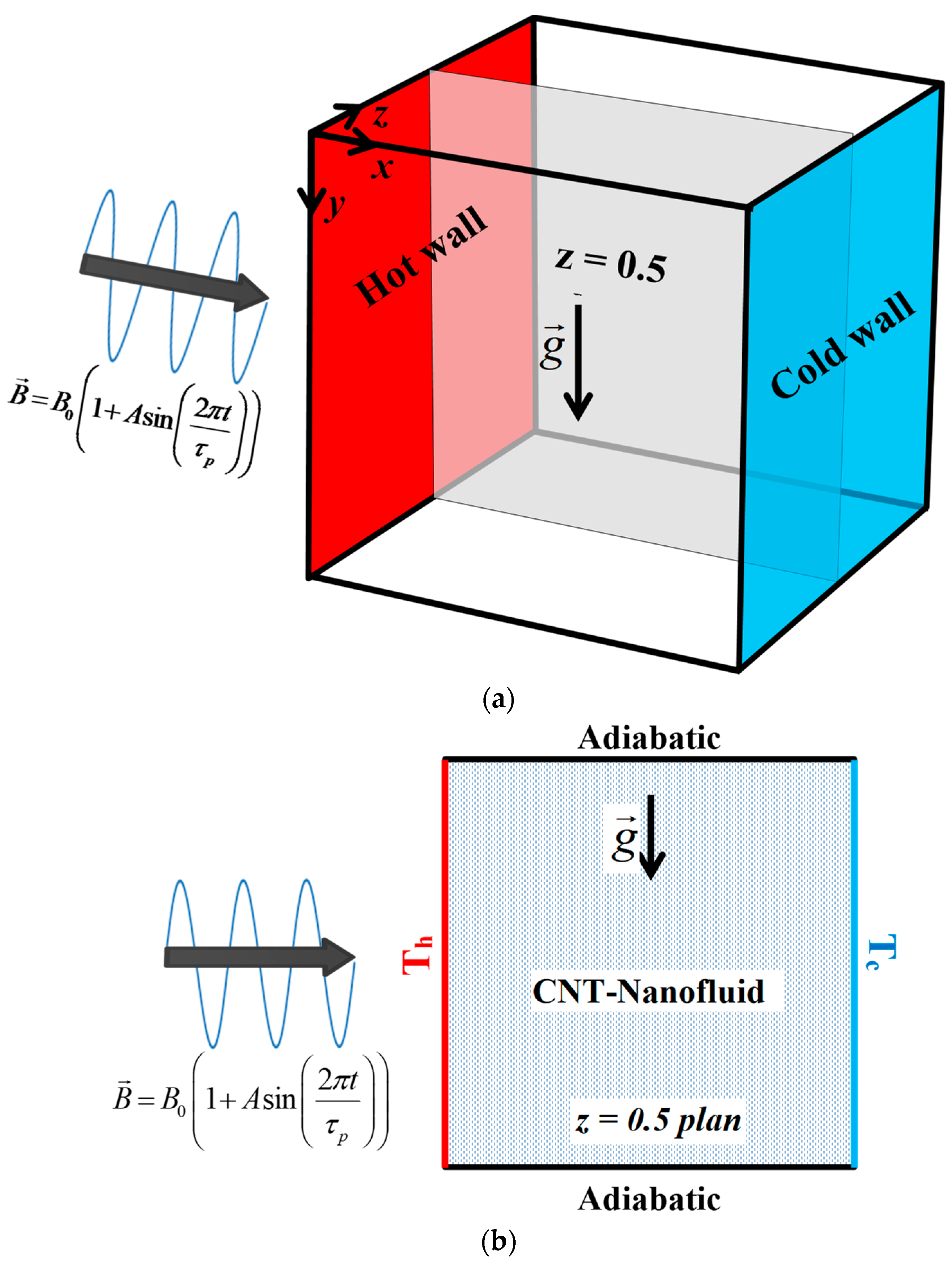
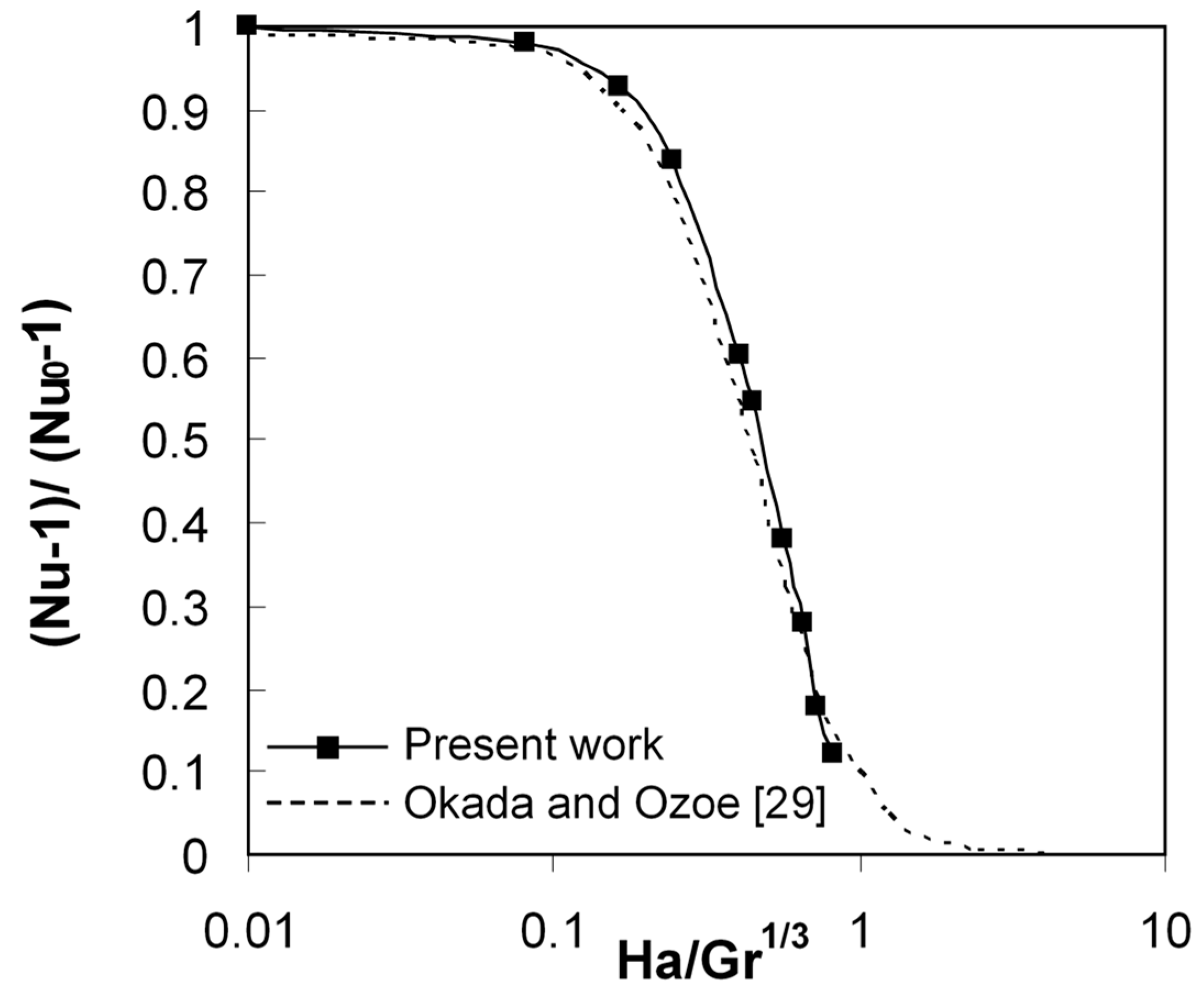

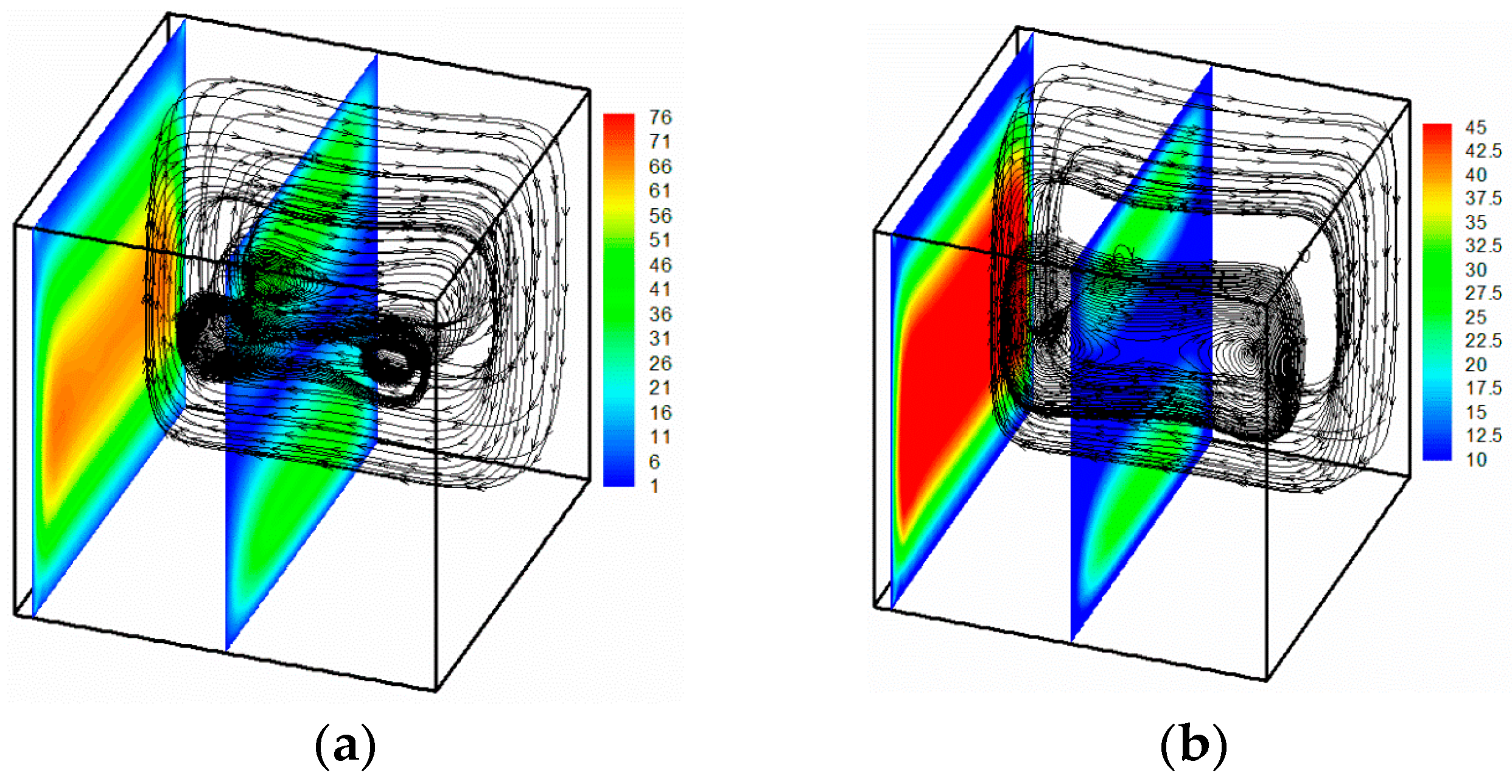
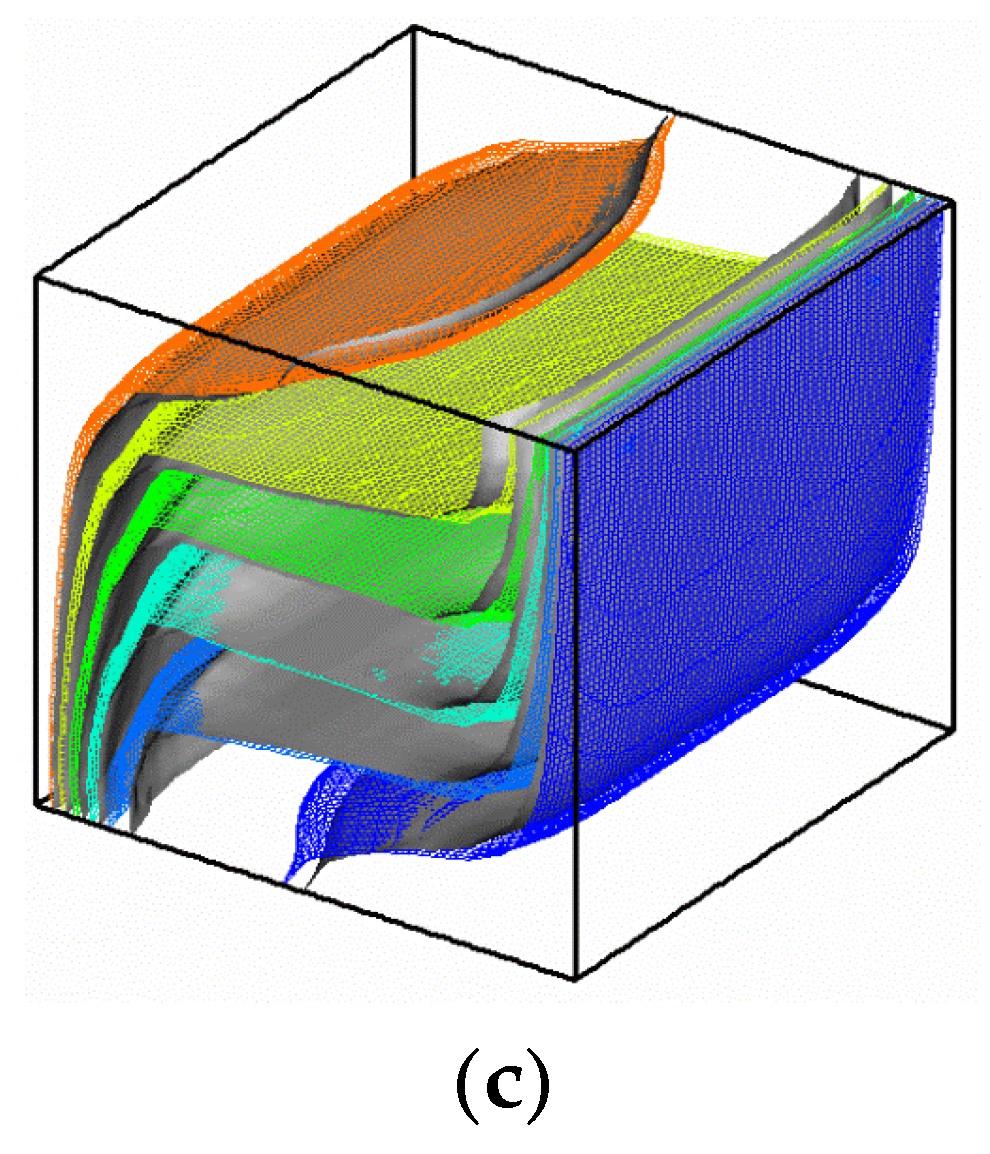
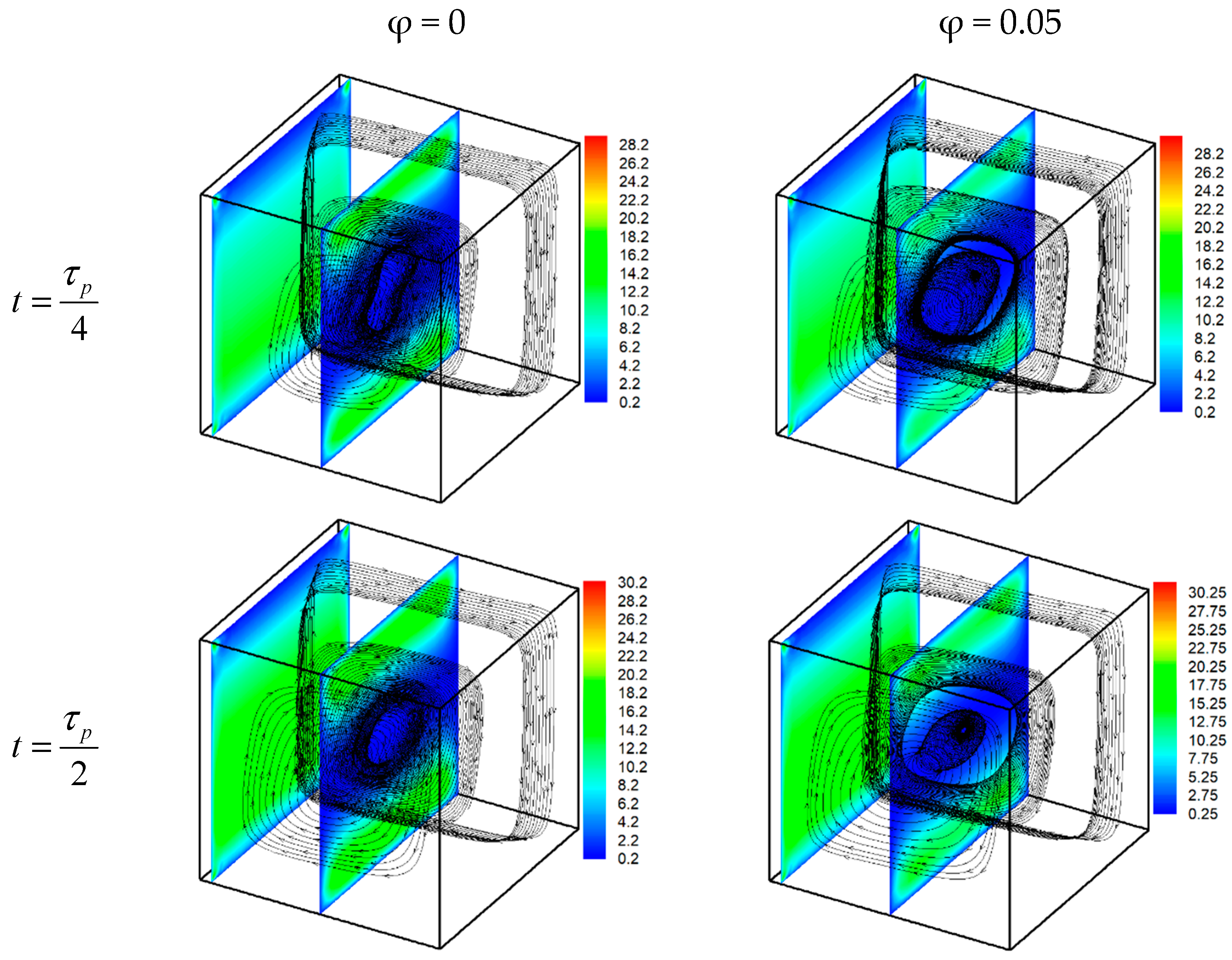
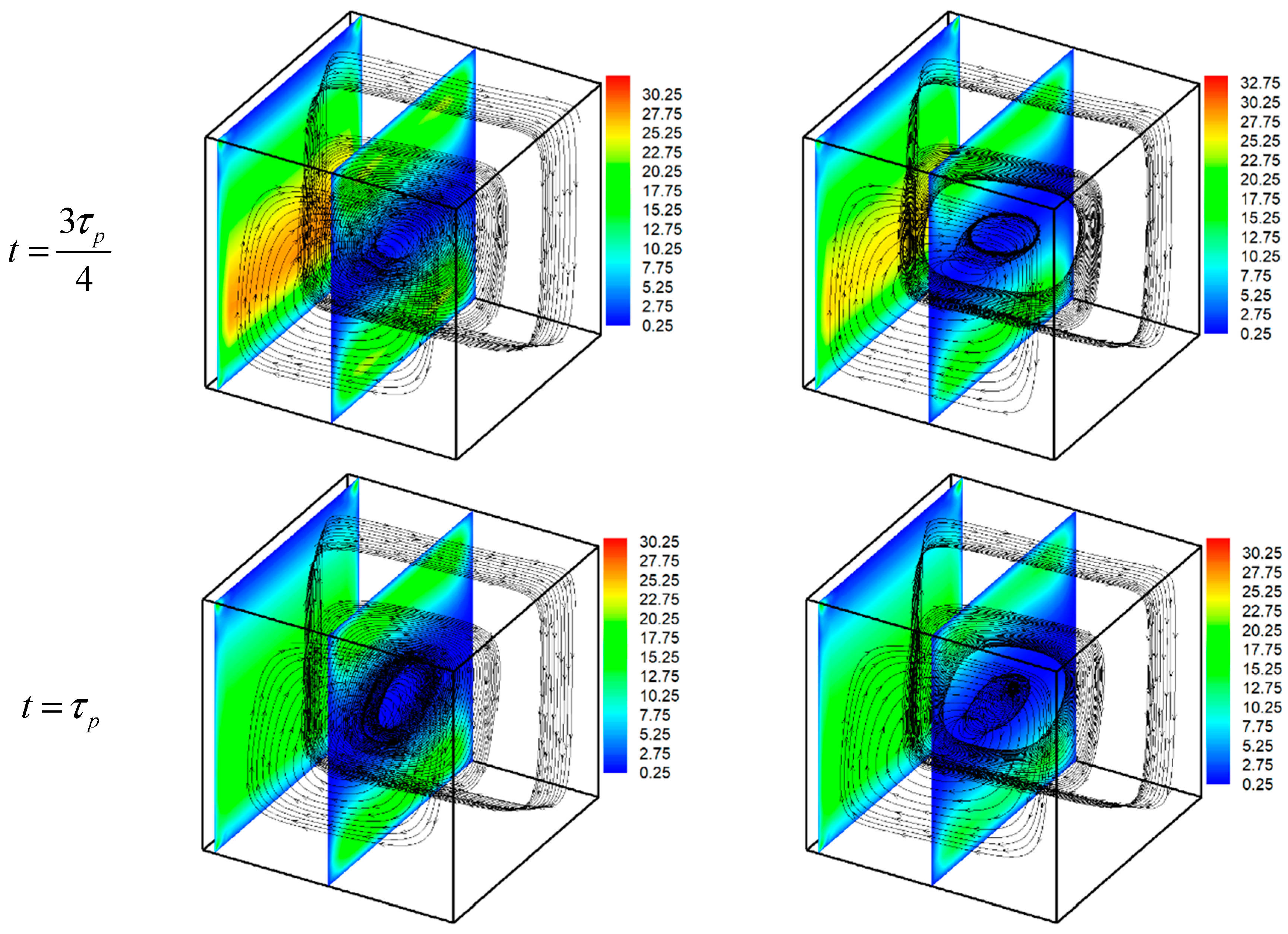
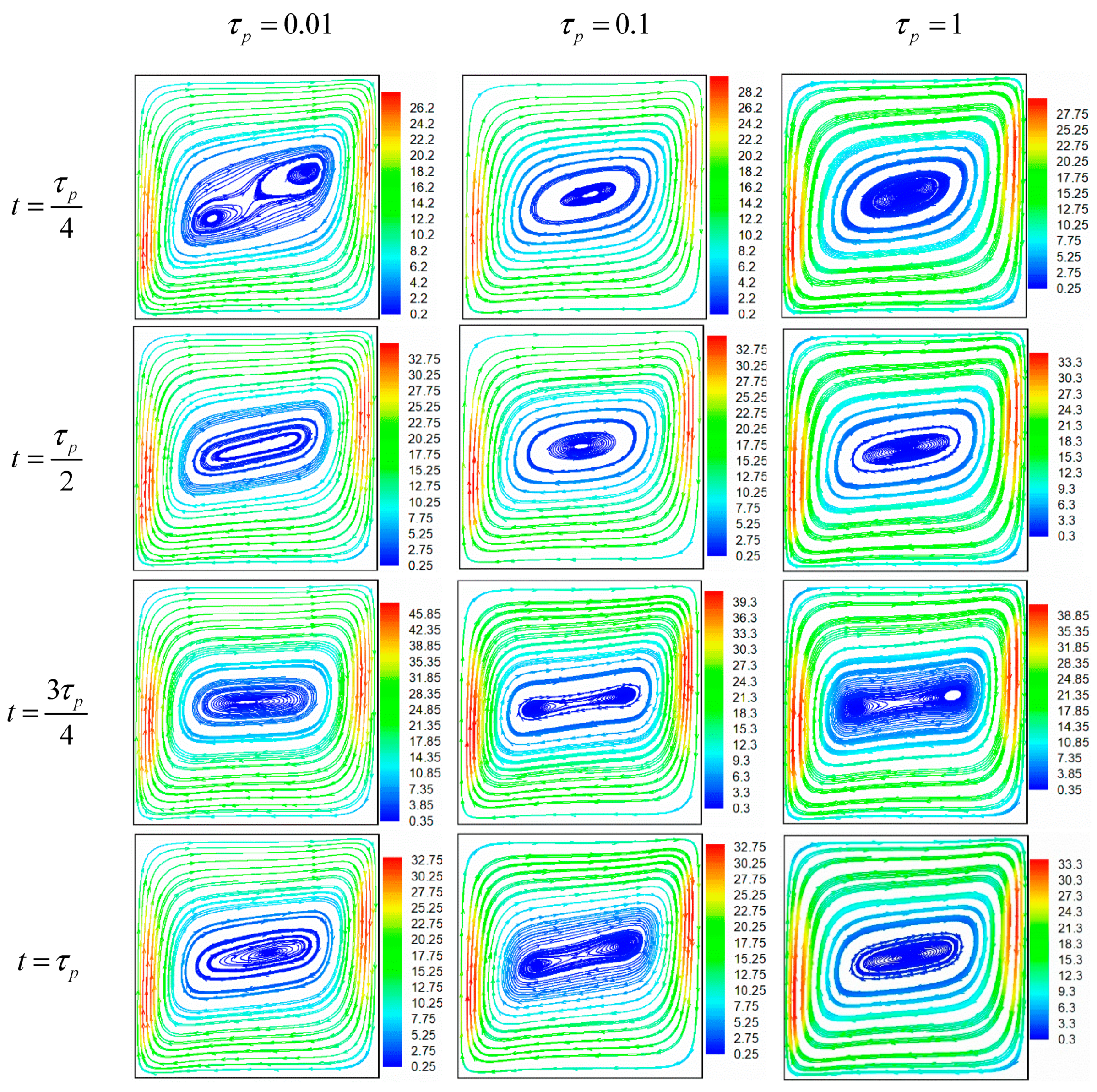

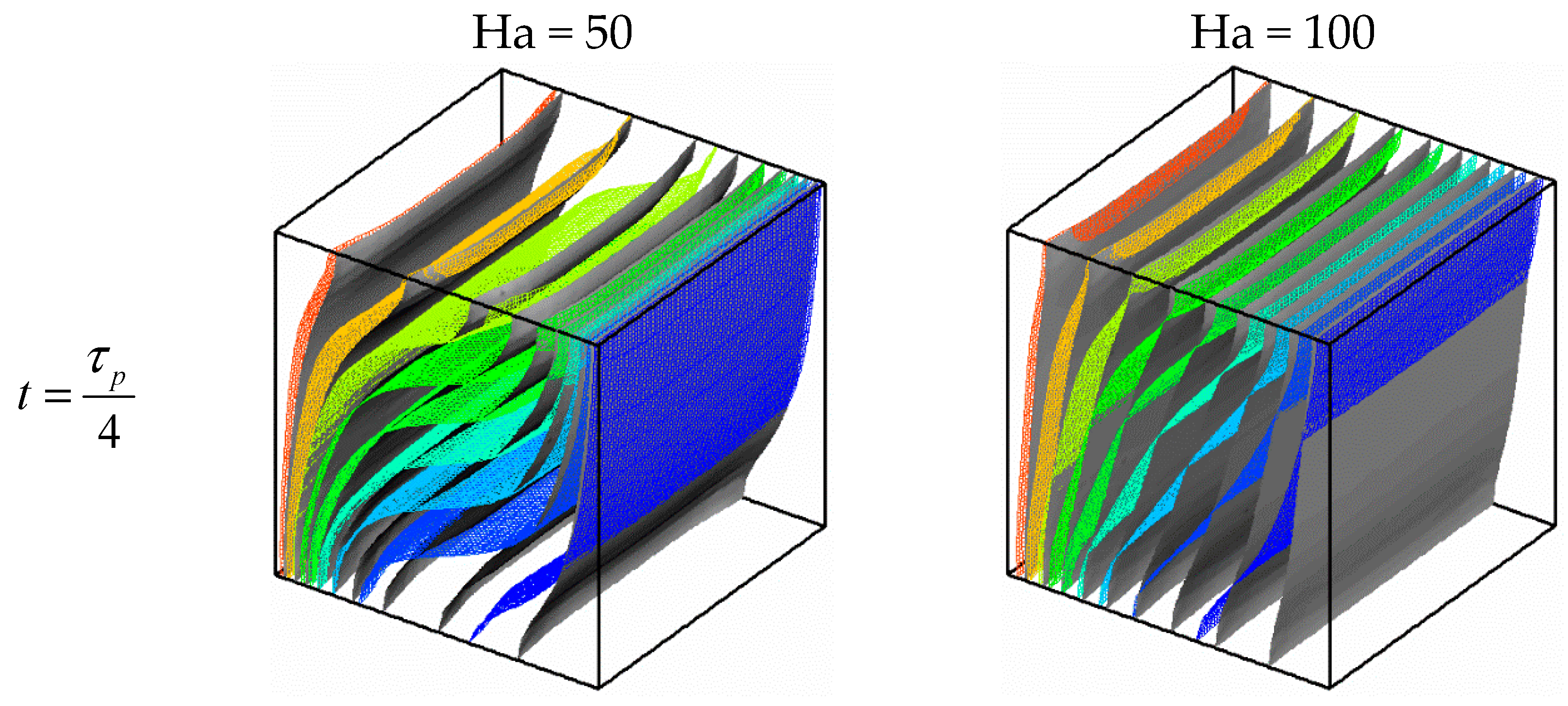
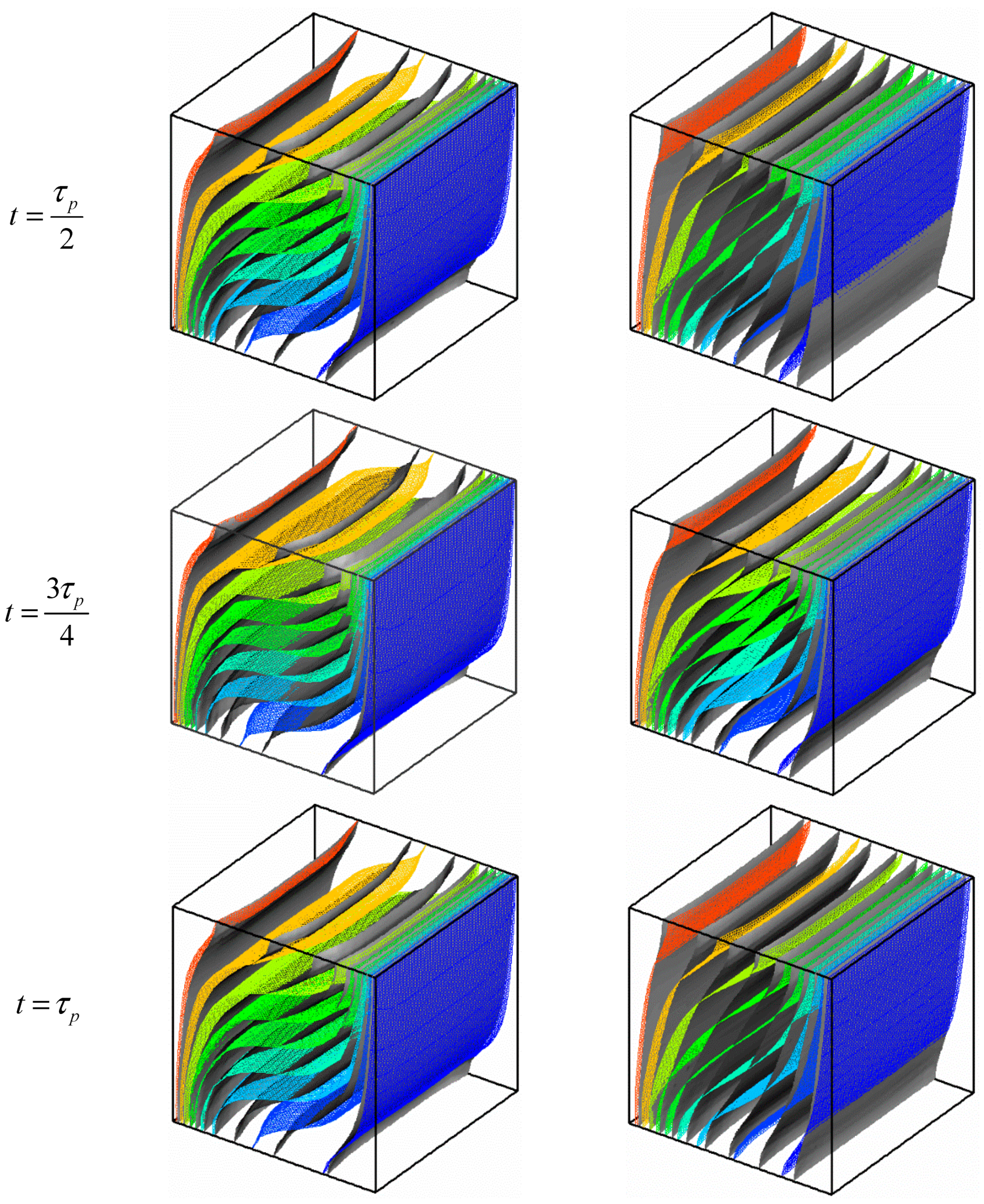

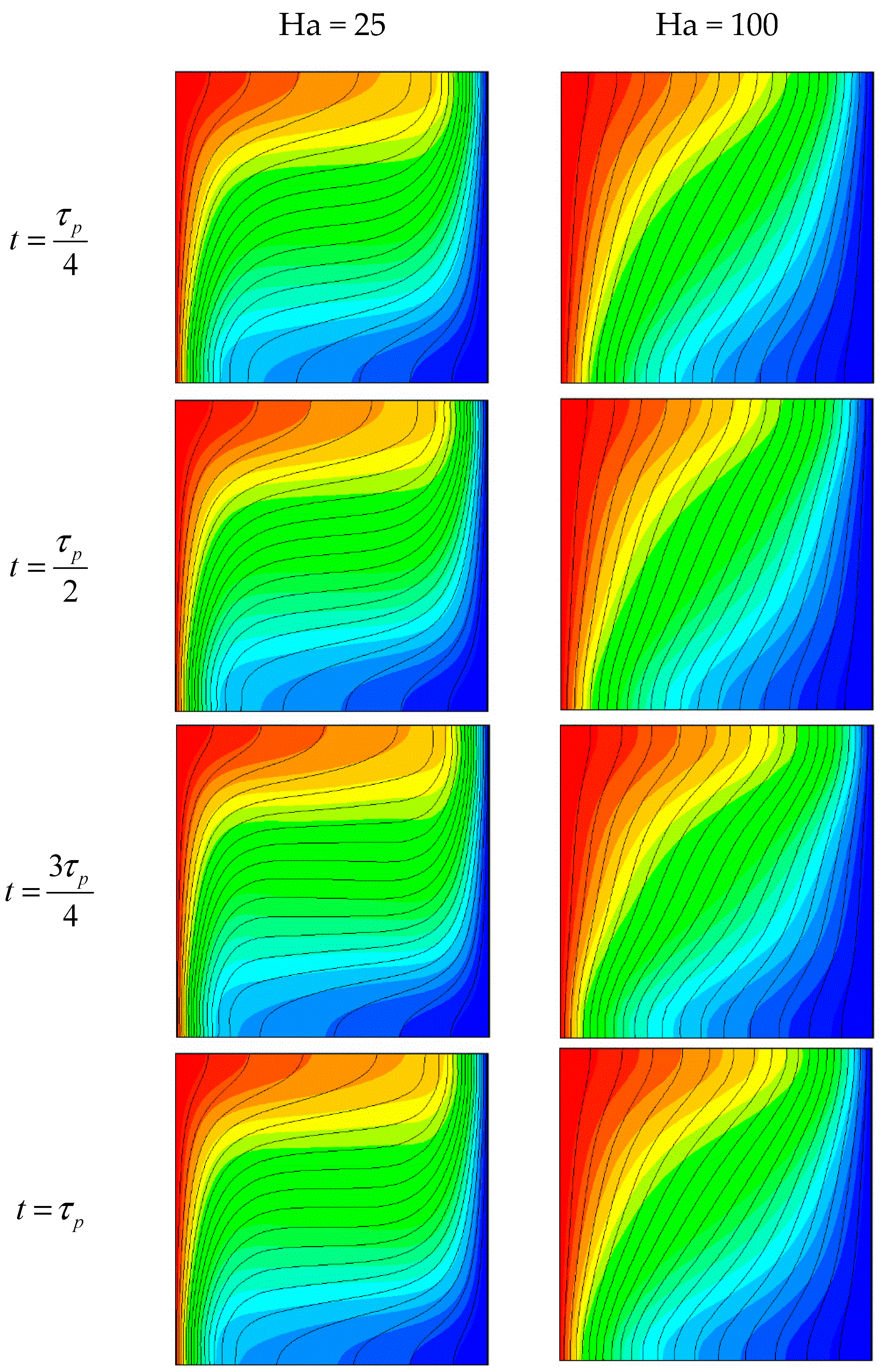
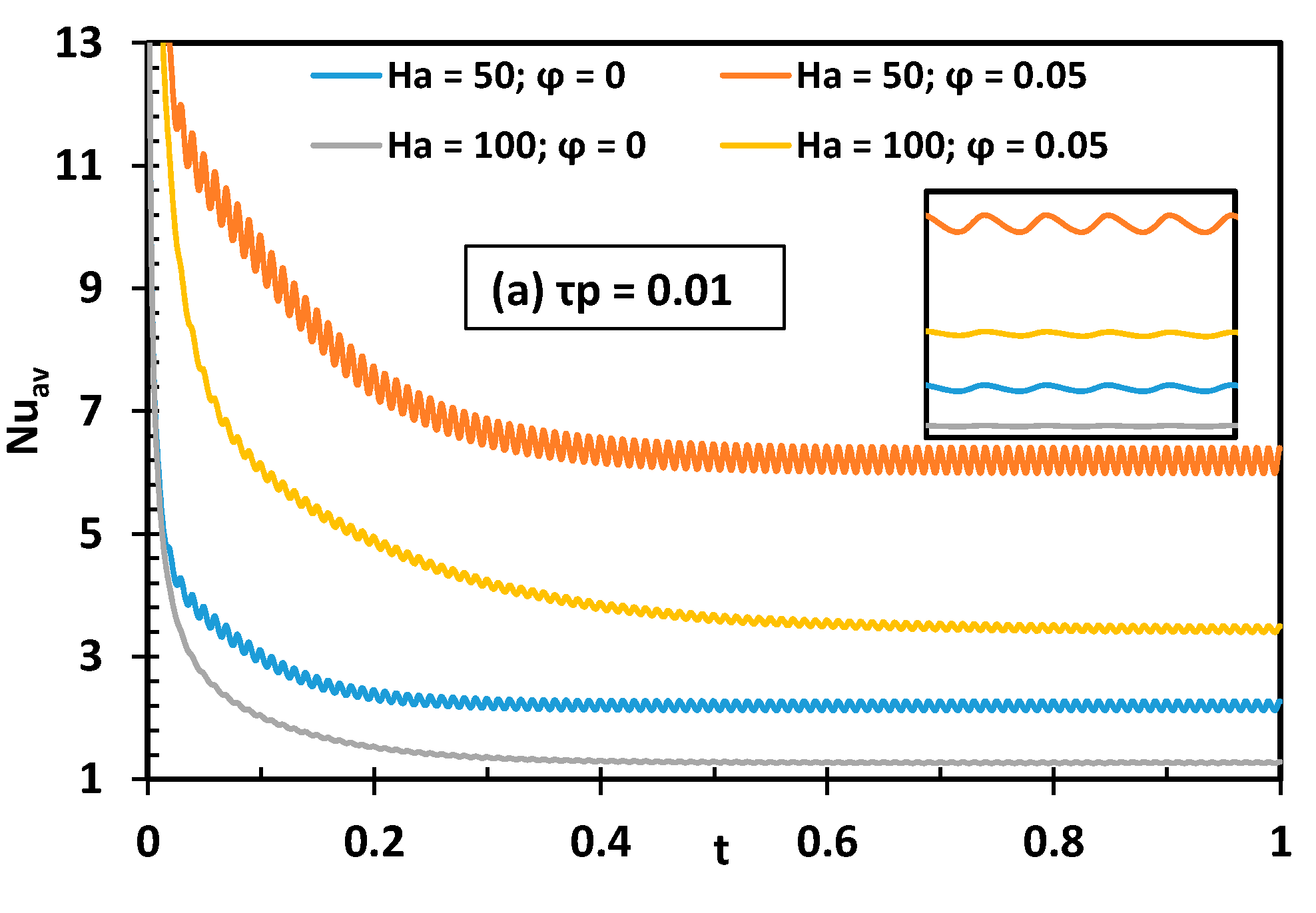



| Property | Water | MWCNT |
|---|---|---|
| Cp (kJ/kg·K) | 4.179 | 0.796 |
| (kg/m3) | 997.1 | 1600 |
| (kW/m·K) | 0.613 × 10−3 | 3 |
| (K−1) | 21 × 10−5 | 4.2 × 10−5 |
| · (Ω−1·m−1) | 5 × 10−2 | 4.8 × 10−7 |
| μ (Pa·s) | 0.85 × 10−3 | - |
| Grid | Increase (%) | Incremental Increase | |
|---|---|---|---|
| 61 × 61 × 61 | 6.0251 | - | - |
| 71 × 71 × 71 | 6.04579 | 0.34339679 | - |
| 81 × 81 × 81 | 6.10967 | 1.39999981 | 1.05660302 |
| 91 × 91 × 91 | 6.13002 | 1.73307836 | 0.33307855 |
© 2019 by the authors. Licensee MDPI, Basel, Switzerland. This article is an open access article distributed under the terms and conditions of the Creative Commons Attribution (CC BY) license (http://creativecommons.org/licenses/by/4.0/).
Share and Cite
Kolsi, L.; Oztop, H.F.; Ghachem, K.; Almeshaal, M.A.; Mohammed, H.A.; Babazadeh, H.; Abu-Hamdeh, N. Numerical Study of Periodic Magnetic Field Effect on 3D Natural Convection of MWCNT-Water/Nanofluid with Consideration of Aggregation. Processes 2019, 7, 957. https://doi.org/10.3390/pr7120957
Kolsi L, Oztop HF, Ghachem K, Almeshaal MA, Mohammed HA, Babazadeh H, Abu-Hamdeh N. Numerical Study of Periodic Magnetic Field Effect on 3D Natural Convection of MWCNT-Water/Nanofluid with Consideration of Aggregation. Processes. 2019; 7(12):957. https://doi.org/10.3390/pr7120957
Chicago/Turabian StyleKolsi, Lioua, Hakan F. Oztop, Kaouther Ghachem, Mohammed A. Almeshaal, Hussein A. Mohammed, Houman Babazadeh, and Nidal Abu-Hamdeh. 2019. "Numerical Study of Periodic Magnetic Field Effect on 3D Natural Convection of MWCNT-Water/Nanofluid with Consideration of Aggregation" Processes 7, no. 12: 957. https://doi.org/10.3390/pr7120957
APA StyleKolsi, L., Oztop, H. F., Ghachem, K., Almeshaal, M. A., Mohammed, H. A., Babazadeh, H., & Abu-Hamdeh, N. (2019). Numerical Study of Periodic Magnetic Field Effect on 3D Natural Convection of MWCNT-Water/Nanofluid with Consideration of Aggregation. Processes, 7(12), 957. https://doi.org/10.3390/pr7120957








